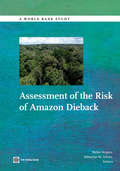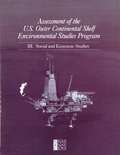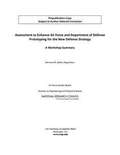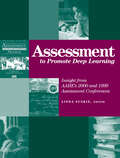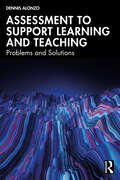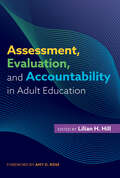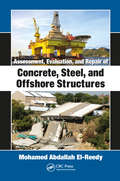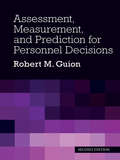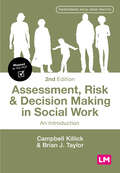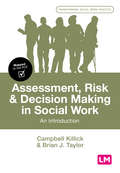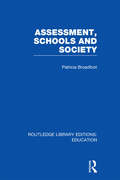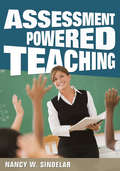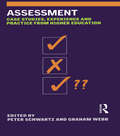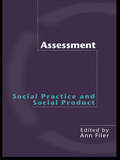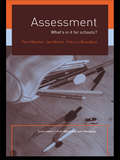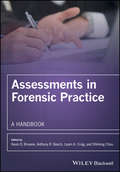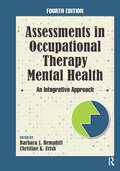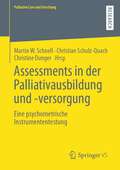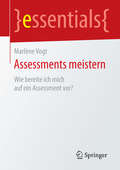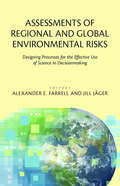- Table View
- List View
Assessment of the Risk of Amazon Dieback
by Walter Vergara Sebastian M. ScholzThe Amazon basin is a key component of the global carbon cycle. Not only is the old-growth rainforests in the basin huge carbon storage with about 120 billion metric tons of carbon in their biomass, but they also process annually twice the rate of global anthropogenic fossil fuel emissions through respiration and photosynthesis. In addition, the basin is the largest global repository of biodiversity and produces about 20 percent of the world's flow of fresh water into the oceans. Despite the large CO2 efflux from recent deforestation, the Amazon rainforest is still considered to be a net carbon sink or reservoir because vegetation growth on average exceeds mortality. However, current climate trends and human-induced deforestation may be transforming forest structure and behavior. Amazon forest dieback would be a massive event, affecting all life-forms that rely on this diverse ecosystem, including humans, and producing ramifications for the entire planet. Clearly, with changes at a global scale at stake, there is a need to better understand the risk, and dynamics of Amazon dieback. Therefore, the purpose of the book is to assist in understanding the risk, process and dynamics of potential Amazon dieback and its implications.
Assessment of the Role of Intermittent Preventive Treatment for Malaria in Infants: Letter Report
by Institute of Medicine of the National AcademiesIntermittent Preventive Treatment for Malaria in Infants (IPTi) is a new strategy which aims to combine the short-term protection of chemoprophylaxis with the long-term protection of naturally acquired immunity. <P><P>The Bill and Melinda Gates Foundation requested that the Institute of Medicine (IOM) conduct an independent assessment (with emphasis on the work done by the IPTi consortium) of the utility, safety, and operational aspects of IPTi to provide a comprehensive, and transparent analysis. In order to fully examine the issue of IPTi, the IOM convened a committee to evaluate the evidence concerning Intermittent Preventive Treatment for Malaria in Infants using sulfadoxine-pyrimethamine (IPTi-SP).The resulting book contains the findings, conclusions, and recommendations of the IOM committee. Overall, the Committee finds that the evidence presented supports the case for continued investment in IPTi-SP as a promising public health strategy to diminish the morbidity from malaria infections among infants at high risk.
Assessment of the SBIR and STTR Programs at the National Institutes of Health
by Policy and Global Affairs Board on Science, Technology, and Economic Policy National Academies of Sciences, Engineering, and Medicine Committee on the Assessment of the SBIR and STTR Programs at NIHThe National Institutes of Health (NIH) asked the National Academies of Sciences, Engineering, and Medicine to conduct a quadrennial review of its Small Business Innovation Research (SBIR) and Small Business Technology Transfer (STTR) programs, in accordance with a legislative mandate. Using quantitative and qualitative analyses of data, this report reviews the operations and outcomes stemming from NIH's SBIR/STTR awards. Drawing on published research and conducting new analyses based on both publicly available data and applicant data provided by NIH, Assessment of the SBIR and STTR Programs at the National Institutes of Health analyzes (1) the effectiveness of NIH's processes and procedures for selecting SBIR and STTR awardees; (2) the effectiveness of NIH's outreach to increase SBIR and STTR applications from small businesses that are new to the programs, from underrepresented states, and from woman-owned and minority-owned businesses; (3) collaborations between small businesses and research institutions resulting from the programs; and (4) a range of direct economic and health care impacts attributable to the programs.
Assessment of the U.S. Outer Continental Shelf Environmental Studies Program: III. Social and Economic Studies
by Socioeconomics PanelThis is the third of four volumes from the Committee to Review the Outer Continental Shelf (OCS) Environmental Studies Program (ESP). The first two dealt with physical, oceanographic, and ecological aspects of the program.This book presents the findings of the panel's investigation of the social and economic relevance of OCS oil and gas activities and the social and economic aspects of the ESP.It describes the potential effects of OCS activities on the human environment, presents an ideal socioeconomic studies program, and comments on the current program in the Atlantic, Gulf of Mexico, Pacific, and Alaska regions.
Assessment to Enhance Air Force and Department of Defense Prototyping for the New Defense Strategy
by National Research Council Division on Engineering and Physical Sciences Air Force Studies Board Norman M. Haller Planning Committee for a Workshop on Assessment to Enhance Air Force and Department of Defense Prototyping for the New Defense StrategyAssessment to Enhance Air Force and Department of Defense Prototyping for the New Defense Strategy is the summary of a workshop convened by the Air Force Studies Board of the National Academies' National Research Council in September 2013 to enhance Air Force and Department of Defense (DoD) prototyping for the new defense strategy. This workshop examined of a wide range of prototyping issues, including individual recommendations for a renewed prototype program, application of prototyping as a tool for technology/system development and sustainment (including annual funding), and positive and negative effects of a renewed program. Prototyping has historically been of great benefit to the Air Force and DoD in terms of risk reduction and concept demonstration prior to system development, advancing new technologies, workforce enhancement and skills continuity between major acquisitions, dissuasion of adversaries by demonstrating capabilities, maintaining technological surprise through classified technologies, and an overarching strategy of overall risk reduction during austere budget environments. Over the last two decades, however, many issues with prototyping have arisen. For example, the definitions and terminology associated with prototyping have been convoluted and budgets for prototyping have been used as offsets to remedy budget shortfalls. Additionally, prototyping has been done with no strategic intent or context, and both government and industry have misused prototyping as a key tool in the DoD and defense industrial base. Assessment to Enhance Air Force and Department of Defense Prototyping for the New Defense Strategy envisions a prototyping program that encourages innovation in new concepts and approaches and provides a means to assess and reduce risk before commitment to major new programs.
Assessment to Promote Deep Learning: Insight from AAHE’s 2000 and 1999 Assessment Conferences
by Linda SuskieThis edited collection of presentations by major speakers at AAHE's 1999 and 2000 Assessment Conferences offers cutting-edge ideas from: Jorge Klor de Alva; Noel Entwistle; James Anderson; Victor Borden; Jean MacGregor, Vincent Tinto, Jerri Holland Lindblad; Barbara Wright; and others. Questions explored include: (1) How does a successful for-profit institution define and assess its learning outcomes and use that information to develop programs? (2) How can we create curricula and assessments that promote "deep" learning that endures, rather than superficial surface learning? (3) What is an effective performance indicator, and what keys determine the best utilization in varied situations? (4) What have we learned from assessments of the learning community movement? (5) How can we use both assessment and accreditation to promote cultural change?
Assessment to Support Learning and Teaching: Problems and Solutions
by Dennis AlonzoThis book outlines the key problems associated with the intersections of assessment, learning and teaching, and presents guiding principles to effective assessment that schools can follow in order to optimise student outcomes.Addressing challenges such as competing conceptualisations of assessment, the burden of responsibility on teachers and conflicting views of what effective assessment actually is, this book provides an in-depth analysis of these problems, how they are explored, what factors influence them and their implications for learning and teaching. It proposes practical solutions to address these challenges, supported by 29 case studies that capture examples of practice from Asia, Europe, the USA and Australia. The book concludes with the key features of the effective implementation of assessment reform, based on findings from a variety of scenarios, across different contexts and levels of education.Providing critical insights and practical guidance, this book is an essential reference for teachers, school leaders and postgraduate students of education.
Assessment, Evaluation, and Accountability in Adult Education
by Lilian H. Hill Amy D. RoseThis book is intended to help practitioners in adult education become better informed about assessment, evaluation, and accountability as these are critical functions of administering and running adult education programs. The book is for adult educators who have been asked to serve on assessment committees, produce detailed reports for funders and accreditors, create a culture of assessment within their program and organization, and/or develop reports for accountability purposes. Section one presents an introductory overview of assessment and evaluation in adult education. Section two gives guidance on practices for specific areas of adult education practice, such as military education, human resource development, and continuing professional education. Section three provides assessment practices for adults in higher education, with chapters dedicated to distance learning, health professions education, and graduate education.
Assessment, Evaluation, and Repair of Concrete, Steel, and Offshore Structures
by Mohamed Abdallah El-ReedyCivil engineers must assure that buildings have long and durable lives, and therefore structural assessment and repair are routinely required and must be performed with the utmost accuracy and professionalism. Assessment, Evaluation, and Repair of Concrete, Steel, and Offshore Structures presents the typical causes of structural failure and their mechanisms, discusses the most up-to-date methods for evaluation and structural assessment, and explains the best project management strategies from the feasibility stage through operations and maintenance. Numerous types of structures are examined and are further illustrated by relevant case studies. Features: Examines the probability of several types of structural failure and includes reliability analysis. Presents best practices for predicting the structural lifetime for both onshore and offshore structures and reviews the most advanced methods for repair. Includes numerous practical case studies of structural failure and offers mitigation strategies depending of type of structure.
Assessment, Measurement, and Prediction for Personnel Decisions: Second Edition
by Robert M. GuionRobert Guion’s best seller is now available in this new second edition. This noted book offers a comprehensive and practical view of assessment –based personnel decisions not available elsewhere in a single source. This edition more frankly evaluates the current research and practice and presents challenges that will change the basic thinking about staffing systems. This new edition suggests new directions for research and practice, includes emphasis on modern computers and technology useful in assessment, and pays more attention to prediction of individual growth and globalization challenges in the assessment process. The book will be of interest to faculty and students in Industrial Organizational psychology, human resource management and business. IO psychologists in private business and public sector organizations who have responsibilities for staffing and an interest in measurement and statistics will find this book useful.
Assessment, Risk and Decision Making in Social Work: An Introduction (Transforming Social Work Practice Series)
by Brian J. Taylor Campbell KillickAs a practising social worker, you will need to be able to make sound judgments in complex contexts and when you are under pressure. This book covers the essential knowledge you will need to understand and develop skills in relation to professional judgement and decision making processes, including: - the use of assessment tools; - engagement in assessment and decision processes; - the context of risk, complexity and uncertainty in practice; - communication and management of risk within social care processes.
Assessment, Risk and Decision Making in Social Work: An Introduction (Transforming Social Work Practice Series)
by Brian J. Taylor Campbell KillickAs a practising social worker, you will need to be able to make sound judgments in complex contexts and when you are under pressure. This book covers the essential knowledge you will need to understand and develop skills in relation to professional judgement and decision making processes, including: - the use of assessment tools; - engagement in assessment and decision processes; - the context of risk, complexity and uncertainty in practice; - communication and management of risk within social care processes.
Assessment, Risk and Decision Making in Social Work: An Introduction (Transforming Social Work Practice Series)
by Brian Taylor Campbell KillickAs practising social workers, your students will need to be able to make sound judgments in complex contexts and when they are under pressure. This book covers the essential knowledge they will require to understand and develop skills in relation to professional judgement and decision making processes, including: - the use of assessment tools; - engagement in assessment and decision processes; - the context of risk, complexity and uncertainty in practice; - communication and management of risk within social care processes.
Assessment, Risk and Decision Making in Social Work: An Introduction (Transforming Social Work Practice Series)
by Brian Taylor Campbell KillickAs practising social workers, your students will need to be able to make sound judgments in complex contexts and when they are under pressure. This book covers the essential knowledge they will require to understand and develop skills in relation to professional judgement and decision making processes, including: - the use of assessment tools; - engagement in assessment and decision processes; - the context of risk, complexity and uncertainty in practice; - communication and management of risk within social care processes.
Assessment, Schools and Society (Routledge Library Editions: Education)
by Patricia BroadfootThe 1970s saw a growing worldwide pre-occupation with school assessment; Britain witnessed lengthy debate in response to the proposals for examination reform initiated by the Schools Council, and the setting up of an Assessment of Performance Unit to monitor standards of achievement. This book analyzes the origins of school assessment and of international trends in practice, and explores the ideology of assessment which is now so widely accepted yet rarely questioned.
Assessment-Powered Teaching
by Dr Nancy W. SindelarEverything you need to become an assessment-powered teacher is right here! Knowledge is power, and this book puts assessment data and instruction together in a step-by-step format. Instead of dreading the time testing takes from teaching, you can harness its power to define learning targets, build standards-based assessments, and develop data-driven teaching strategies. Assessment expert Nancy W. Sindelar provides testimonials from teachers, data analysis examples, and tools that help teachers: Use formative and summative assessment results to enhance instruction Motivate students by providing clear learning targets Utilize technology to analyze students’ progress Raise test scores
Assessment: Case Studies, Experience and Practice (Case Studies Of Teaching In Higher Education)
by Peter Schwartz and Graham WebbThe fourth volume in this series deals with one of the ubiquitous higher and further education subjects. With a practice-based approach, the text avoids being overly academic and instead uses a case study format to detail a wide range of approaches to assessment.
Assessment: Getting it Right in a Week (Getting it Right in a Week)
by Martin Fautley Alison DaubneyIs assessment just a tick box exercise for you? Are you able to integrate assessment into your everyday teaching? Are you sure that your assessment of learners leads to learning gains? This book acknowledges that you are the expert in your own particular context and allows you to take control of assessment for your learners and yourself. It presents strategies and responds to current educational challenges, offering a variety of assessment approaches and a straightforward toolkit of ideas for effective assessment. Designed to be read over a week, the book is divided into seven concise chapters detailing clear strategies, examining the strategy in action and summarising the underpinning theory. So sit back and enjoy exploring what meaningful assessment can do for you and your learners.
Assessment: Social Practice And Social Product (Social World Ser.)
by Ann FilerAssessment has become one of the most significant areas of interest in educational policy development, as well as the focus of complex political, economic and cultural expectations for change. Increasingly, governments worldwide have become aware that curricula and teachers can be indirectly controlled through programmes of assessment. Opponents of centralized systems of mass assessment claim they are ill-suited to the diverse and changing needs of learners and users of assessment. In this text, the UK and US writers take the reader beyond the obvious functions of assessment, and focus upon the roles it performs in the social structuring of society. They examine the myths and assumptions that underpin assessment and testing and draw attention to its cultural context. This collection is devoted explicitly to socio-cultural studies of assessment and attempts to map the terrain of some 30 years of study in the field. Chapters are organized thematically, with background text providing comparative perspectives, key issues and further reading. The book provides a wide-ranging, structured and accessible approach to the study of socio-cultural origins and impacts of assessment.
Assessment: What's In It For Schools? (What's in it for schools?)
by Jan Winter Patricia Broadfoot Paul WeedenThere has been much debate on the purposes and methods of assessment over the last couple of years. This book gathers together the latest thinking and looks at how assessment can be used to promote or inhibit learning. Unlike other books on the market, this one summarizes theory and shows how it can be best put into practice, using as little jargon as possible. Some of the issues discussed in this text include: * how assessment can erode self-esteem and motivation* how skills of reflection, self-evaluation and personal target setting can impact on learning* how far learners of all ages understand what they are required to learn* how far students are able to evaluate their own performance and what schools can do in the short, medium and long-term to promote more effective learning. Part of the What's In It For Schools series, this book is ideal for teachers and other non-academics concerned with education who require a grounding in the issue to help them in their daily work.
Assessments in Forensic Practice: A Handbook
by Kevin D. Browne Leam A. Craig Anthony R. Beech Shihning ChouAssessments in Forensic Practice: A Handbook provides practical guidance in the assessment of the most frequently encountered offender subgroups found within the criminal justice system. Topics include: criminal justice assessments offenders with mental disorders family violence policy and practice
Assessments in Occupational Therapy Mental Health: An Integrative Approach
by Barbara J. Hemphill Christine K. UrishAssessments in Occupational Therapy Mental Health: An Integrative Approach, Fourth Edition is a unique compilation of mental health assessments that are taught in occupational therapy academic programs and used in clinical practice. This highly anticipated Fourth Edition provides the occupational therapy student and educator with knowledge about the evaluation process, assessments that are current and accurate, and how to generate research for developing assessment tools. Assessments in Occupational Therapy Mental Health, Fourth Edition by Drs. Barbara J. Hemphill and Christine K. Urish, along with more than 30 world-renowned contributors, includes 15 new assessments, along with updates to 9 assessments from the previous editions. Also incorporated throughout the text is the AOTA’s Occupational Therapy Practice Framework, Third Edition. Each chapter includes: A theoretical base on the assessment including historical development, rationale for development, behaviors assessed, appropriate patient use, review of literature, and assessment administration How the instrument is administered, which includes the procedure, problems with administering, and materials needed The presentation of a case study and interpretation of results Statistical analysis and recent studies Suggestions for further research to continue the development and refinement of assessments in occupational therapy mental health New to the Fourth Edition: Kawa Model Assessment Spirituality Model of Human Occupation Assessments Assessments Measuring Activities of Daily Living Some of the topics included in the Fourth Edition: Evidence-based practice The interviewing process Psychological assessments Cognitive assessments / learning assessments Behavioral assessments Biological and spiritual assessments While introducing new assessments and updated information, Assessments in Occupational Therapy Mental Health: An Integrative Approach, Fourth Edition is ideal for occupational therapy faculty, students, practitioners, as well as nurses, psychologists, and social workers.
Assessments in der Palliativausbildung und -versorgung: Eine psychometrische Instrumententestung (Palliative Care und Forschung)
by Martin W. Schnell Christine Dunger Christian Schulz-QuachDie Steuerung der Patientenbehandlung in der Palliativversorgung erfolgt durch Assessmentinstrumente. Sie erfassen den Zustand des Patienten, seine Symptome, Bedürfnisse und erleichtern die weitere Planung. Eine gelungene Verwendung derartiger Instrumente beinhaltet, dass sie gültig, sensibel und zuverlässig sind. Diesem Nachweis dient die Instrumententestung. Am Beispiel von Assessments der Palliativversorgung wird in diesem Band eine solche Testung vorgeführt, erläutert und reflektiert.
Assessments meistern: Wie bereite ich mich auf ein Assessment vor? (essentials)
by Marlène VogtDieses Essential zeigt Ihnen, was Sie in einem Assessment erwartet und wie Sie sich darauf vorbereiten können. Zu diesem Zweck wird dargestellt, wie ein Assessment typischerweise aufgebaut ist, mit welchen Aufgaben und Übungen Sie konfrontiert sein werden und wie Sie diese am besten meistern können. Darüber hinaus erhalten Sie Anregungen, wie Sie mithilfe von klaren Zielformulierungen und einer ,,bewussten Haltung" während des Assessments Ihr Bestes geben und Ihre Kompetenzen unter Beweis stellen können.
Assessments of Regional and Global Environmental Risks: Designing Processes for the Effective Use of Science in Decisionmaking
by Alexander E. Farrell Jill Professor JägerAs environmental challenges grow larger in scale and implications, it is increasingly important to apply the best scientific knowledge in the decisionmaking process. Editors Farrell and J?ger present environmental assessments as the bridge between the expert knowledge of scientists and engineers on the one hand and decisionmakers on the other. When done well, assessments have a positive impact on public policy, the strategic decisions of private firms, and, ultimately, the quality of life for many people. This book is the result of an international, interdisciplinary research project to analyze past environmental assessments and understand how their design influenced their effectiveness in bringing scientific evidence and insight into the decisionmaking process. The case studies in the book feature a wide range of regional and global risks, including ozone depletion, transboundary air pollution, and climate change. Assessments of Regional and Global Environmental Risks offers several important contributions. It provides a clear account of the choices faced in the design of environmental assessments and a clear description of the lessons learned from past assessments. It illustrates why assessments are social processes, not simply reports. And, while they identify no universal, one-size-fits-all design, the authors find that, to be effective, environmental assessments must be viewed by those who produce and use them as being salient; credible in their scientific support; and legitimate, or fair in design and execution.
